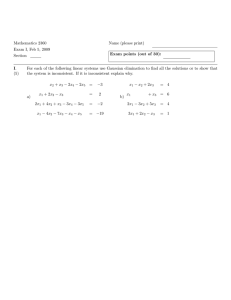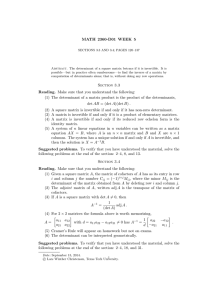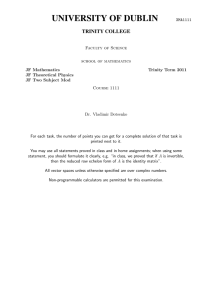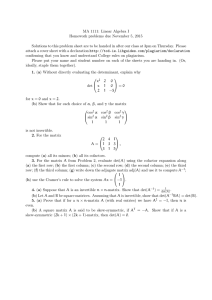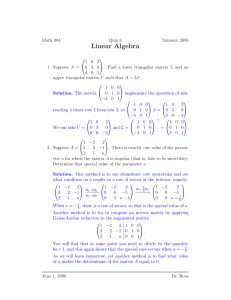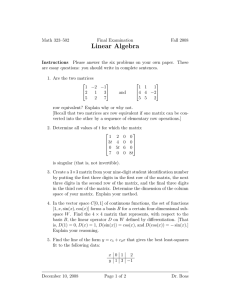MATH 323 Linear Algebra Lecture 6: Matrix algebra (continued).
advertisement
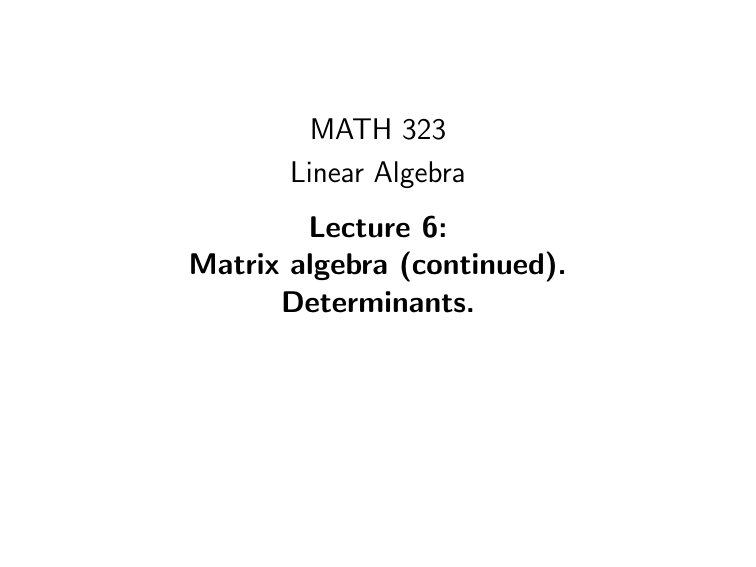
MATH 323
Linear Algebra
Lecture 6:
Matrix algebra (continued).
Determinants.
Elementary matrices
Theorem 1 Any elementary row operation σ on matrices
with n rows can be simulated as left multiplication by a certain
n×n matrix Eσ (called an elementary matrix).
Theorem 2 Elementary matrices are invertible.
Proof: Suppose Eσ is an n×n elementary matrix
corresponding to an operation σ. We know that σ can be
undone by another elementary row operation τ . It is easy to
check that σ undoes τ as well. Then for any matrix A with n
rows we have Eτ Eσ A = A (since τ undoes σ) and Eσ Eτ A = A
(since σ undoes τ ). In particular, Eτ Eσ I = Eσ Eτ I = I , which
implies that Eτ = Eσ−1 .
Theorem 3 A square matrix is invertible if and only if it can
be expanded into a product of elementary matrices.
Theorem Suppose that a sequence of elementary row
operations converts a matrix A into the identity matrix.
Then the same sequence of operations converts the identity
matrix into the inverse matrix A−1 .
Proof: Let E1 , E2 , . . . , Ek be elementary matrices that
correspond to elementary row operations converting A into I .
Then Ek Ek−1 . . . E2 E1 A = I .
Applying the same sequence of operations to the identity
matrix I , we obtain the matrix
B = Ek Ek−1 . . . E2 E1 I = Ek Ek−1 . . . E2 E1 .
Therefore BA = I . Besides, B is invertible since elementary
matrices are invertible. Then B −1 (BA) = B −1 I . It follows
that A = B −1 , hence B = A−1 .
Theorem A square matrix A is invertible if and only if x = 0
is the only solution of the matrix equation Ax = 0.
Corollary 1 For any n×n matrices A and B,
BA = I ⇐⇒ AB = I .
Proof: It is enough to prove that BA = I =⇒ AB = I .
Assume BA = I . Then Ax = 0 =⇒ B(Ax) = B0
=⇒ (BA)x = 0 =⇒ x = 0. By the theorem, A is invertible.
Then BA = I =⇒ A(BA)A−1 = AIA−1 =⇒ AB = I .
Corollary 2 Suppose A and B are n×n matrices. If the
product AB is invertible, then both A and B are invertible.
−1
Proof: Let C = B(AB)
and D = (AB)−1 A. Then
−1
AC = A B(AB) = (AB)(AB)−1 = I and
DB = (AB)−1 A B = (AB)−1 (AB) = I . By Corollary 1,
C = A−1 and D = B −1 .
Transpose of a matrix
Definition. Given a matrix A, the transpose of A,
denoted AT , is the matrix whose rows are columns
of A (and whose columns are rows of A). That is,
if A = (aij ) then AT = (bij ), where bij = aji .
T
1 4
1 2 3
= 2 5 ,
Examples.
4 5 6
3 6
T
T
7
4
7
4
7
8 = (7, 8, 9),
=
.
7 0
7 0
9
Properties of transposes:
• (AT )T = A
• (A + B)T = AT + B T
• (rA)T = rAT
• (AB)T = B T AT
• (A1 A2 . . . Ak )T = ATk . . . AT2 AT1
• (A−1)T = (AT )−1
Definition. A square matrix A is said to be
symmetric if AT = A.
For example, any diagonal matrix is symmetric.
Proposition For any square matrix A the matrices
B = AAT and C = A + AT are symmetric.
Proof:
B T = (AAT )T = (AT )T AT = AAT = B,
C T = (A + AT )T = AT + (AT )T = AT + A = C .
Determinants
Determinant is a scalar assigned to each square matrix.
Notation. The determinant of a matrix
A = (aij )1≤i,j≤n is denoted det A or
a a ... a 1n 11 12
a a ... a 2n 21 22
.
..
.
.
.
.
. ... .
.
an1 an2 . . . ann Principal property: det A 6= 0 if and only if a
system of linear equations with the coefficient
matrix A has a unique solution. Equivalently,
det A 6= 0 if and only if the matrix A is invertible.
Definition in low dimensions
a b
= ad − bc,
Definition. det (a) = a, c d
a11 a12 a13 a21 a22 a23 = a11a22 a33 + a12a23a31 + a13a21a32 −
a31 a32 a33 −a a a − a a a − a a a .
13 22 31
+:
−:
*
∗
∗
∗
∗
*
∗
*
∗
∗
*
∗
∗
∗
∗ , ∗
*
*
*
∗
∗ , *
∗
∗
*
∗
∗
*
∗
∗
12 21 33
∗
* ,
∗
∗
∗ ,
*
11 23 32
∗
*
∗
∗
∗
*
*
∗
∗
∗
∗
*
*
∗ .
∗
∗
* .
∗
Examples: 2×2 matrices
3 0
1 0
0 −4 = − 12,
0 1 = 1,
7 0
−2 5 5 2 = 14,
0 3 = − 6,
0 0
0 −1 4 1 = 0,
1 0 = 1,
2 1
−1 3 8 4 = 0.
−1 3 = 0,
Examples: 3×3 matrices
3 −2 0 1 0 1 = 3 · 0 · 0 + (−2) · 1 · (−2) + 0 · 1 · 3 −
−2 3 0 − 0 · 0 · (−2) − (−2) · 1 · 0 − 3 · 1 · 3 = 4 − 9 = −5,
1 4 6
0 2 5 = 1·2·3+4·5·0+6·0·0−
0 0 3
− 6 · 2 · 0 − 4 · 0 · 3 − 1 · 5 · 0 = 1 · 2 · 3 = 6.
General definition
The general definition of the determinant is quite
complicated as there is no simple explicit formula.
There are several approaches to defining determinants.
Approach 1 (original): an explicit (but very
complicated) formula.
Approach 2 (axiomatic): we formulate
properties that the determinant should have.
Approach 3 (inductive): the determinant of an
n×n matrix is defined in terms of determinants of
certain (n − 1)×(n − 1) matrices.
Classical definition
Definition. If A = (aij ) is an n×n matrix then
X
sgn(π) a1,π(1) a2,π(2) . . . an,π(n) ,
det A =
π∈Sn
where π runs over Sn , the set of all permutations of
{1, 2, . . . , n}, and sgn(π) denotes the sign of the
permutation π.
Remarks. • A permutation of the set {1, 2, . . . , n} is an
invertible mapping of this set onto itself. There are n! such
mappings.
• The sign sgn(π) can be 1 or −1. Its definition is rather
complicated.
Axiomatic definition
Mn,n (R): the set of n×n matrices with real entries.
Theorem There exists a unique function
det : Mn,n (R) → R (called the determinant) with
the following properties:
(D1) if a row of a matrix is multiplied by a scalar
r , the determinant is also multiplied by r ;
(D2) if we add a row of a matrix multiplied by a
scalar to another row, the determinant remains the
same;
(D3) if we interchange two rows of a matrix, the
determinant changes its sign;
(D4) det I = 1.
Corollary 1 Suppose A is a square matrix and B is
obtained from A applying elementary row operations.
Then det A = 0 if and only if det B = 0.
Corollary 2 det B = 0 whenever the matrix B has
a zero row.
Hint: Multiply the zero row by the zero scalar.
Corollary 3 det A = 0 if and only if the matrix A
is not invertible.
Idea of the proof: Let B be the reduced row echelon form of
A. If A is invertible then B = I ; otherwise B has a zero row.
Remark. The same argument proves that properties
(D1)–(D4) are enough to evaluate any determinant.
Row echelon form of a square matrix A:
∗
∗
∗
∗
∗
∗
∗
∗
∗
∗
∗
∗
∗
∗
∗
∗
∗
∗
∗
∗
∗
det A 6= 0
∗
∗
∗
∗
∗
∗
∗
∗
∗
∗
∗
∗
∗
∗
∗
∗
∗
∗
det A = 0
3 −2 0
Example. A = 1 0 1, det A =?
−2 3 0
In the previous lecture, we have transformed the
matrix A into the identity matrix using elementary
row operations:
•
•
•
•
•
•
•
•
interchange the 1st row with the 2nd row,
add −3 times the 1st row to the 2nd row,
add 2 times the 1st row to the 3rd row,
multiply the 2nd row by −0.5,
add −3 times the 2nd row to the 3rd row,
multiply the 3rd row by −0.4,
add −1.5 times the 3rd row to the 2nd row,
add −1 times the 3rd row to the 1st row.
3 −2 0
Example. A = 1 0 1, det A =?
−2 3 0
In the previous lecture, we have transformed the
matrix A into the identity matrix using elementary
row operations.
These included two row multiplications, by −0.5
and by −0.4, and one row exchange.
It follows that
det I = − (−0.5) (−0.4) det A = (−0.2) det A.
Hence det A = −5 det I = −5.
